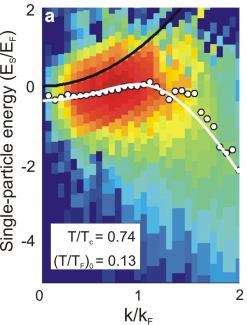In 2008, the Deborah Jin Group introduced a new technique, known as atom photoemission spectroscopy, to study a strongly interacting ultracold gas cloud of potassium (40K) atoms at the crossover point between Bose-Einstein condensation and superfl uidity via the pairing of fermionic atoms (See JILA Light & Matter, Summer 2008). Near the crossover point, the physics of superfl uidity in an atom gas system may be connected to that of high-temperature superconductivity.
In the 2008 experiment, the researchers discovered an energy gap in their superfl uid gas. The atom gas was fi lled with atom pairs that were dancing in sync even though they didn’t actually form molecules. The energy gap corresponded to the minimum energy required to break apart the pairs back into single atoms.
Here’s a good way to think about the energy gap: If you put a tiny amount of energy into an ideal Fermi gas, you can excite a fermionic atom and make it move faster. If the system has an energy gap, however, then amounts of energy smaller than the gap cannot excite one of the atoms. You need energy equal to or larger than the gap to excite atoms. The gap exists because you have to put in enough energy to break apart a pair of fermions before you can excite either one of them.
That’s why finding and measuring the gap was so exciting back in 2008. This experiment was conducted at a temperature, known as Tc, which is the point at which a superfl uid forms. The observation of a gap fi t with conventional theory. This theory predicted that pairs of Fermi atoms would act in synchrony below Tc, creating an energy gap. The same theory predicted that above Tc, no atom pairs would form, and thus no energy gap would exist. Similar relationships were predicted to hold true for superconductivity in solid materials.
Interestingly, the prediction that the gap must disappear above Tc held true for all superconducting materials except high-temperature superconductors. In high-temperature superconductors, researchers do see a gap in the region above Tc. This anomaly recently piqued the curiosity of the Jin group and their theorist colleagues from Italy’s Universitá di Camerino. They began to wonder what would happen to the gap in an ultracold atom gas at temperatures above Tc. After all, conventional theory predicts that pairing disappears along with the gap.
So, the Jin group team, led by graduate student John Gaebler, repeated its photoemission spectroscopy experiment with a gas of 40K atoms above Tc and, sure enough, they observed a gap! Gaebler was assisted in this unexpected discovery by former graduate student Jayson Stewart and graduate student Tara Drake.
“We think our observation means that there are still pairs of atoms hanging together at the higher temperature, despite the fact there is no longer a superfl uid,” Gaebler said. He added that if he’s correct, then what he and his colleagues observed is a very exotic state of matter. To further complicate the picture, other things you can measure in cold-atom gases turn out to be consistent with conventional theory. The Jin group’s theorist colleagues in Italy are hard at work fi guring out exactly what is going on here.
The new results raise the question of what is similar about high-temperature superconductors and strongly interacting superfl uid Fermi gases. For starters, the new results from the Jin group clearly demonstrate the existence of an energy gap in strongly interacting Fermi gases both below and above Tc; the same is true of high-temperature superconductors.
So, Gaebler is back at work refi ning his measurements, evaluating other techniques for exploring the gap, and understanding the effects of laser trapping on his results. Ultimately, he wants to not only observe, but also understand the transition from pairing to nonpairing in an ultacold gas of 40K atoms. This understanding will increase our knowledge of how such behavior relates to what happens in high-temperature superconductivity. - Julie Phillips



 The Physics Frontiers Centers (PFC) program supports university-based centers and institutes where the collective efforts of a larger group of individuals can enable transformational advances in the most promising research areas. The program is designed to foster major breakthroughs at the intellectual frontiers of physics by providing needed resources such as combinations of talents, skills, disciplines, and/or specialized infrastructure, not usually available to individual investigators or small groups, in an environment in which the collective efforts of the larger group can be shown to be seminal to promoting significant progress in the science and the education of students. PFCs also include creative, substantive activities aimed at enhancing education, broadening participation of traditionally underrepresented groups, and outreach to the scientific community and general public.
The Physics Frontiers Centers (PFC) program supports university-based centers and institutes where the collective efforts of a larger group of individuals can enable transformational advances in the most promising research areas. The program is designed to foster major breakthroughs at the intellectual frontiers of physics by providing needed resources such as combinations of talents, skills, disciplines, and/or specialized infrastructure, not usually available to individual investigators or small groups, in an environment in which the collective efforts of the larger group can be shown to be seminal to promoting significant progress in the science and the education of students. PFCs also include creative, substantive activities aimed at enhancing education, broadening participation of traditionally underrepresented groups, and outreach to the scientific community and general public.